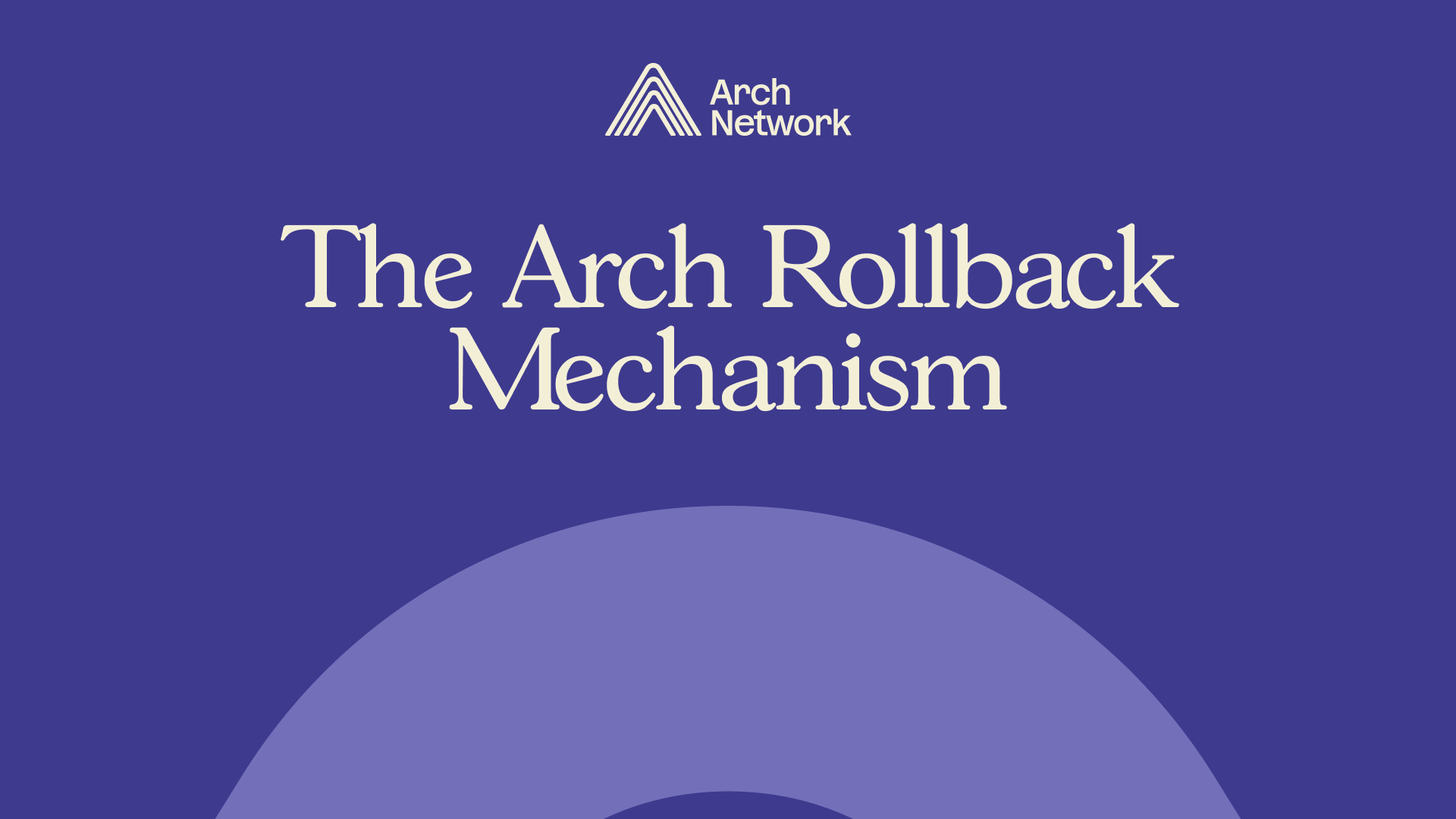Using "Rollback & Reapply" To Maintain State Consistency
This post introduces our rollback and reapply architecture — an elegant solution to cross-chain inconsistency — enabling developers to build confidently even under volatile network conditions.

Transaction finality and state consistency are fundamental requirements for building reliable applications.
However, when you're building on top of Bitcoin, the most secure and decentralized blockchain in existence, those guarantees come with new challenges.
At Arch, we've developed robust mechanisms that allow developers to harness Bitcoin's trust model — without sacrificing performance or reliability.
This post introduces our rollback and reapply architecture — an elegant solution to cross-chain inconsistency — enabling developers to build confidently even under volatile network conditions.
You can also read the full whitepaper here.
Bitcoin Finality is Both a Strength and a Challenge
Bitcoin is the gold standard for security and censorship resistance. But it was never designed for high-speed, stateful applications.
Core features of Bitcoin, including its …
- Slow and variable confirmation times (typically 10+ minutes)
- Probabilistic finality (chains can be reorged several blocks deep)
- UTXO model (which lacks global state context)
...make it difficult to build complex, stateful applications directly on Bitcoin.
This creates a core dilemma: how can developers build high-performance applications that still anchor trust in Bitcoin?
Arch Solves This.
We bridge Bitcoin's security model with fast, expressive stateful execution by anchoring application state to Bitcoin — while still offering a powerful Solana-like developer experience.
But with this power comes complexity.
The Problem: Cross-Chain Inconsistency
When applications rely on Bitcoin finality to confirm transactions, they must also account for:
- Delayed anchoring: Bitcoin confirmations aren't instant. Transactions may be in limbo for 10 minutes or more.
- Chain reorganizations: Transactions that appeared final can be invalidated by a longer Bitcoin chain.
- Partial failure: If only part of a transaction graph anchors correctly, the system must decide what to keep and what to roll back.
Without strong consistency mechanisms, this could lead to:
- Broken application state
- Inconsistent or double-spent assets
- Lost user funds or security vulnerabilities
Arch’s Rollback and Reapply Solution
At Arch, we built a transaction graph model and rollback/reapply mechanisms to enforce deterministic, consistent state — even under the volatile conditions of cross-chain interaction with Bitcoin.
Transaction Graph Architecture
Every transaction in Arch is a node in a directed acyclic graph (DAG):
- Nodes: individual transactions
- Edges: dependencies between them
- Source nodes: transactions with no parents
This structure allows us to efficiently trace the impact of any transaction and manage partial failures gracefully.
Rollback: Responding to Bitcoin Failures
If a Bitcoin-anchored transaction fails to confirm (e.g. due to a dropped transaction, chain reorg, or mempool eviction), Arch initiates a rollback.
Rollback Triggers:
- A transaction has been anchored but is missing from the confirmed Bitcoin chain
- Any state-only transactions that depend on failed transactions
- Already-rolled-back transactions are skipped
How Rollback Works:
- Graph Construction
- Start at the failed transaction
- Walk backward to gather dependencies
- Walk forward to identify affected children
- Validation
- Confirm anchoring status of each transaction
- Exclude previously rolled back nodes
- Recursive Rollback
- Recursively traverse and mark all affected transactions
- Apply rollback in dependency-aware order
Example
Imagine a chain T1 → T2 → T3:
- T1: Anchored & confirmed in Bitcoin
- T2: State-only
- T3: Anchored but missing in Bitcoin
If T3 fails:
- T3 is marked for rollback
- T2 is examined (state-only, but depends on T3)
- T1 is skipped (it's confirmed)
Reapply: Reacting to Bitcoin Confirmations
When a previously failed transaction gets confirmed later (e.g. after mempool congestion clears), Arch can reapply it and its children transactions (those that are dependent on it).
Reapply Triggers:
- Transaction was rolled back, but its Bitcoin anchor is now confirmed
- Dependencies are now valid
- State-only transactions whose parents are valid
Reapply Process:
- Graph Rebuild
- Start at reapply candidate
- Rebuild dependencies
- Traverse forward to include affected children
- Topological Execution
- Ensure dependencies execute in correct order
Example
Same chain: T1 → T2 → T3
- T3 is later confirmed on Bitcoin
- Arch identifies T3 as a reapply candidate
- T2 is also reapplied (if it was rolled back)
- T1 remains untouched
Why This Matters for Developers
Without rollback and reapply, building apps that integrate with Bitcoin would require:
- Manual error handling
- Custom transaction logic
- Painful user experiences
With Arch …
- You don’t have to worry about Bitcoin quirks
- Your application logic stays clean
- You gain the security of Bitcoin with the speed of a high-performance chain
Building on Bitcoin, Without the Pain
Bitcoin is the most battle-tested blockchain in the world—but building on it directly is hard.
Arch gives developers the tools to build sophisticated, high-throughput applications that still anchor to Bitcoin for trust and finality.
Our rollback and reapply mechanisms are a core part of that infrastructure — keeping state consistent, applications stable, and developer lives easier.
Want to go deeper? Read our full whitepaper or reach out to our developer team on Discord to learn how to build with Arch.

